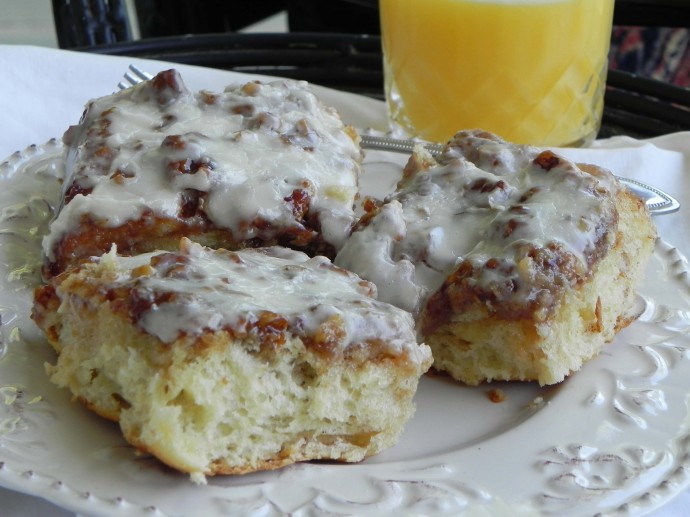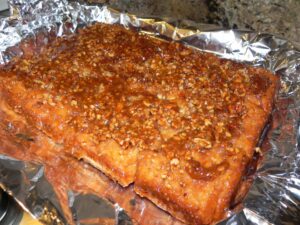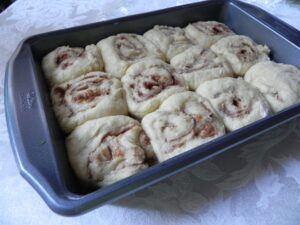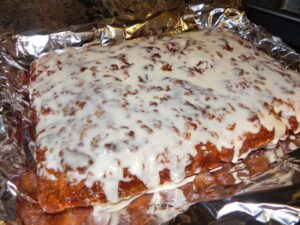Uncategorized
On Cooking Southern: Yeast Unleashed

By Laurie Triplette
ldtriplette@aol.com
Southernism of the Week
No-count: (No-account) Not worth a hill of beans (another expression meaning virtually worthless). When used to describe a person, the term implies strongly that the worthless person is full of horse hockey, due, in part, to a failed upbringing… As in, “that no-count brother of yours left the riding lawnmower outside the fence with the key in the ignition, and now he wonders where it disappeared to.”
RISE HIGH WITH YEASTY BAKED GOODS
It’s alive, it’s alive!!!!
I’m not talking about Dr. Frankenstein’s monster. I’m talking about YEAST, a friendly fungus that has helped elevate mankind above the apes for tens of thousands of years. Many otherwise competent cooks are scared to death to confront it.
Fear not, fellow foodies.
The friendly fungus called Sacchharomyces exiguous (also known as S. minor) is floating all around us in “the wild.” Strains of this wild yeast known as Saccharomyces cereviciae (S. cereviciae) have been used for eons in brewing alcohol and for leavening bread doughs. Saccharomyces means “sugar fungus” — all Saccharomyces strains feed on sugars.
Since the beginning of civilization, where there’s been grain, there’s been yeast. Where there’s been yeast, there’s been grain fermentation. And where there was fermentation, there was leavened bread. Our ancestors thought it was magic. It still is.
Those good ol’ Egyptians 5,000 years ago were writing hieroglyphics about using yeast in their fermentation of alcoholic beverages and leavening for breads. Leaven is mentioned throughout the Bible, as a soft, dough-like medium from which portions were used to aid each new batch of bread dough. Think of leaven as the original sourdough starter.
Early-times bakers began a long tradition of obtaining their leavening agent from the winemakers and from brewers of ale and beer. That first strain used by the ancients and our forefathers for brewing alcoholic beverages became known as brewer’s yeast. A deactivated version is sold today as a nutritional supplement because it is rich in minerals and B vitamins.
The variant strain cultivated to use in leavening bread dough became known during the 19th century as baker’s yeast. S. cereviciae breaks down glucose into energy, producing the byproducts of carbon dioxide (CO2) and ethanol (also known as ethyl alcohol). The brewer’s yeast creates more alcohol in its glucose breakdown than CO2 (which may be used in beer and champagne). The baker’s yeast breaks down glucose through aerobic respiration with oxygen to produce more carbon dioxide than ethanol, which quickly evaporates during baking. The CO2 bubbles cause the dough to rise.
Louis Pasteur discovered in 1859 how yeast fungus cells work, and he proved it with his microscope in 1860. S. cereviciae yeast cells used by the bakers feed on the starches in flour, producing carbon dioxide. The carbon dioxide expands the gluten proteins in the flour, and those expanded proteins cause the dough to expand and rise.
All over Europe, 19th century bakers refined their versions of the S. cereviciae yeast to suit their tastes and needs. The Viennese, in the heart of brewing country, became renowned for their pastries and yeast-based baked goods. The ever-industrious British began commercializing the production of bakers’ yeast by growing S. cerevisiae in large vats and processing it into a cleaned-up slurry of cream yeast.
The world of baker’s yeast took a turn for the better when the brothers Charles and Maximillian Fleischmann left their home in Austria-Hungary for America. The Fleischmann brothers formed a partnership with American businessman James Gaff in 1868 and built a yeast plant in Cincinnati, OH. They patented a process for compressing cream yeast into cakes of live yeast.
They introduced the new cake yeast to 10 million visitors at the 1876 Philadelphia Centennial Exposition. Their best selling tool was the aroma of baking bread wafting throughout the exposition from their “Vienna Bakery” booth.
Foil-wrapped cake yeast became the standard leaven for baking until the mid-20th century. Fleischmanns and a rival American company, Red Star, out of Milwaukee, WI, developed granulated active dry yeast during World War II. The granulated active dry yeast had extended shelf life and did not need refrigeration, unlike the cake yeast, making it possible to keep bread on the table for American troops in combat areas. It is still the standard yeast used in American military recipes.
Having survived World War II, the French company Lesaffre, continued concentrating on research pertaining to yeast, malt, and bioconversions. They introduced Instant Yeast into the U.S. and Canada in 1976. Lesaffre purchased Red Star Yeast in 2001. Today, any yeast sold as SAF or Red Star comes from Lesaffre, and is backed by serious scientific research into the biochemical structure of bakers’ yeast.
In 1984, Fleischmann’s developed RapidRise Yeast, which is another form of instant yeast; and in 1993, the company introduced Bread Machine Yeast, formulated to produce commercial-quality loaves in any bread machine.
For the uninitiated among us home cooks, Rapid Rise and Instant Yeast and Bread Machine Yeast are fairly interchangeable. Unlike Active Dry Yeast, they do not requiring proofing, and only require one dough rise, instead of the usual two risings.
In an interesting 21st century twist within the scientific world, yeast researchers have identified the complete genome structure in S. cerevisiae. Their efforts are making significant inroads into medical cancer research.
As I stated earlier, bakers’ yeast is a good thing … a very good thing.
That’s why, this week, we’re making up a simple sticky bun recipe using Active Dry Yeast. It’s a terrific sweet roll to share with family and friends during the Memorial Day holiday. We’re also throwing in a recipe for saving dough that fails to rise.
Be sure to check in next week, when we develop our own Friendship Bread starter, and a Sourdough Starter that grows from the wild yeast floating in the air. Bill Nye the Science Guy has nothing on us HottyToddy bakers.
ED’S STICKY BUNS
Sis-in-law Andrea got this tasty breakfast roll recipe from her stepson-in-law, Ed Hume. Under Andrea’s guidance, I made up the recipe in the evening and allowed the rolls to rise overnight, baking them for breakfast to serve with bacon or sausage. I won’t indulge often, but when I do, I will consider these very sweet rolls to be healthful due to the honey.
Dough:
1 pkg active dry yeast (2-1/4 tsp)
1/4 c warm water (about 110˚F)
1/2 c all purpose flour
1/3 c white granulated sugar
1 tsp table salt
2 large eggs, beaten
1/4 c whole milk
1 tsp vanilla extract
2 c all purpose flour
6 tsp (3/4 stick) salted butter, softened
 Dissolve yeast in warm water in a small bowl or cup —about 5 minutes. In a large non-reactive bowl (glass, ceramic or stainless), combine dissolved yeast with 1/2 cup of flour, sugar, salt, eggs, milk and vanilla. Mix until completely blended, and stir in remaining (2 c) flour. Mix until dough comes together. It will be very sticky.
Dissolve yeast in warm water in a small bowl or cup —about 5 minutes. In a large non-reactive bowl (glass, ceramic or stainless), combine dissolved yeast with 1/2 cup of flour, sugar, salt, eggs, milk and vanilla. Mix until completely blended, and stir in remaining (2 c) flour. Mix until dough comes together. It will be very sticky.
Butter your hands and knead for 10 minutes until dough is smooth and elastic. Work in the soft (not melted) butter until it has been completely blended into the very sticky dough with no remaining butter lumps. Place the dough into a buttered bowl (I used a 2.5-qt glass bowl). Cover with slightly loose plastic and place in a warm spot to rise until doubled in size, about 1-1/2 hour. Temperature should be about 75-80˚F. (Because my home is air-conditioned, I placed mine on the top railing of stairs to the attic.)
When risen, punch down dough, cover again with plastic, and refrigerate for 30 minutes.
Topping:
1c light brown sugar
8 T (1 stick) salted butter
1/4 c honey
3/4 to 1 c chopped pecans
1 to 2 tsp melted butter
1/3 c light brown sugar
2 tsp ground cinnamon
When dough has been in fridge for 30 minutes, butter a 9-by-13-inch baking pan. Set aside.
Combine 1 c brown sugar with stick of butter, honey and pecans in a medium saucepan. Bring to a rolling boil and immediately remove from heat. Do not continue boiling or it will turn to toffee. Pour syrup mixture into the buttered pan and spread it evenly before it begins to set up.
 Spread out a large piece of parchment paper and dust with flour. Position the dough in the center, and dust dough with flour to reduce the stickiness. Roll out the dough to a rectangle 12 by 16 inches. (I mark measurements on the parchment.)
Spread out a large piece of parchment paper and dust with flour. Position the dough in the center, and dust dough with flour to reduce the stickiness. Roll out the dough to a rectangle 12 by 16 inches. (I mark measurements on the parchment.)
Spread the melted butter over the entire dough surface. Combine the 1/3-cup of brown sugar and cinnamon with a fork in small cup. Sprinkle the mixture evenly across the buttered dough, lightly smoothing it to cover entire surface.
Roll the dough into a jelly roll, lengthwise, using the edge of the parchment paper to help. I found I had to sprinkle flour at intervals and use a spatula or pastry blade to release sticky dough and maintain an even roll.
Once rolled, measure off 12 even slices and cut the slices. Position four rows of 3 three slices in the pan on top of the hardened syrup. Don’t worry that the unbaked rolls are not touching each other.
Cover with plastic and allow the dough to rise again at room temperature until all sides are touching in pan. I let mine rise overnight about 7 hours. On a warm day, the rolls will double in size much more quickly.
Preheat oven to 350˚F. Bake rolls on center rack for 20 to 30 minutes, until tops are browned and syrup has begun bubbling up the sides. DO NOT OVERBAKE OR SYRUP LAYER WILL HARDEN.
Remove to a rack to cool for 5 minutes. Invert still-hot rolls onto a baking sheet or large pan lined with foil to collect dripping syrup. Some of the syrup mixture might remain in baking pan; scrape any still-pliable syrup out and spread on rolls where mixture is thinnest. Do not scrape out darkened or hardened mixture.
Icing on the Topping:
 1 c confectioners sugar
1 c confectioners sugar
2 T melted butter or 3 T hot heavy cream
2 T whole milk
1/2 tsp vanilla extract
Pinch of salt
Splash of rum or coffee, OPTIONAL
Beat the sugar with the milk, vanilla, salt and optional splash of rum or coffee. Mix in the melted butter until smooth, adding additional sugar if using the rum or coffee. The icing will be thin. Drizzle it evenly over top of the cooling rolls. Serve the rolls hot.
RECIPE FOR SAVING FALLEN YEAST DOUGH
If your dough fails to rise after all this effort, it MIGHT be rescued by revitalizing it with a fresh sample of Active Dry Yeast.
For each envelope (or each 2-1/4 tsp) of yeast listed in the recipe, combine in a large warm bowl 1/4 c lukewarm water (100-110˚F), plus 1 tsp white granulated sugar and 2-1/4 tsp of new Active Dry Yeast.
Stir to dissolve and let stand for 10 minutes.
Use an electric mixer and slowly beat small pieces of the unrisen dough (about the size of a walnut) into the proofed yeast . Continue until about half the dough has been added.
Use a mixing spoon to stir in the remaining half of the unrisen dough.
Knead in just enough flour to eliminate stickiness. Loosely cover with warm cloth or oiled plastic and allow the dough to rise according to recipe directions. Continue with original recipe once the dough has risen.
[box style=”0″]
DO’S AND DON’TS FOR HOW TO USE YEAST
Cake yeast lasts about two weeks. Active dry and the various instant yeasts are good for about a year.
Store unopened yeast in a cool, dry place such as a pantry or refrigerator. Once opened, store in an airtight container in the back of the fridge, away from drafts; use within 3-4 months.
Tap water contains chemicals, primarily chlorine, that may kill your yeast. To make sure your yeast doesn’t die, use only distilled or purified water when activating it. The easiest way to remove chlorine from tap water is to boil the water about 5-10 minutes and allow it to cool.
If using a recipe that does not account for activating the dry yeast with liquid, you may need to decrease other liquid in the recipe by 1/4 cup.
To activate Active Dry Yeast, stir the yeast into appropriate measurements of warm water (100-110˚F). Allow to stand 10 minutes. Bubbles should appear as the liquid expands, indicating the presence of carbon dioxide gas..
Most recipes call for adding a small amount of salt with the flour to slow down the yeast activation.
Kneading the dough creates gluten, trapping tiny CO2 bubbles as the yeast ferments, and stretching to give the bread its springy texture. Active Dry Yeast calls for two risings; the instant yeasts require only one.
[/box]
Laurie Triplette is a writer, historian, and accredited appraiser of fine arts, dedicated to preserving Southern culture and foodways. Author of the award-winning community family cookbook GIMME SOME SUGAR, DARLIN’, and editor of ZEBRA TALES (Tailgating Recipes from the Ladies of the NFLRA), Triplette is a member of the Association of Food Journalists (AFJ),Southern Foodways Alliance (SFA) and the Southern Food and Beverage Museum (SOFAB). Check out the GIMME SOME SUGAR, DARLIN’ web site: www.tripleheartpress.com and follow Laurie’s food adventures on Facebook and Twitter (@LaurieTriplette).





























